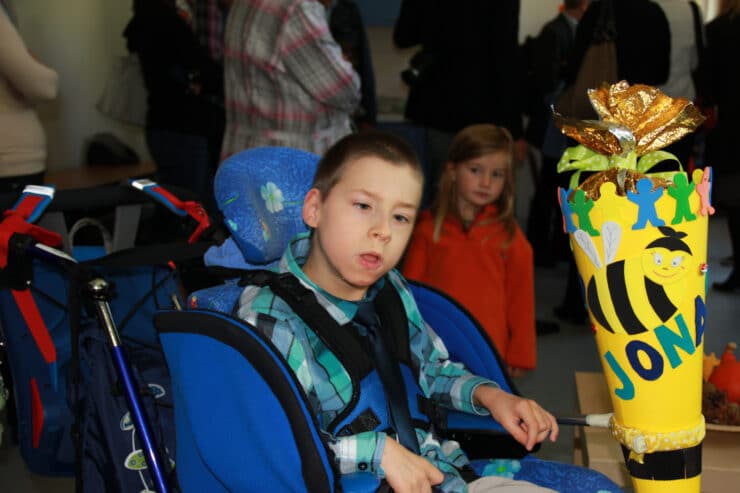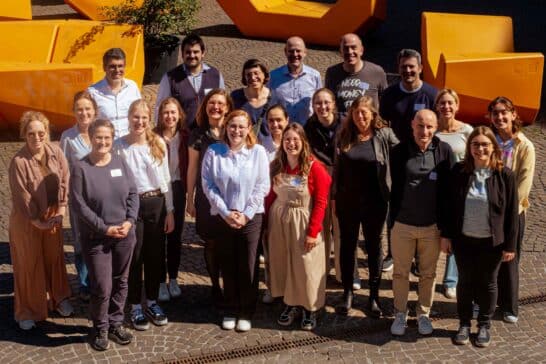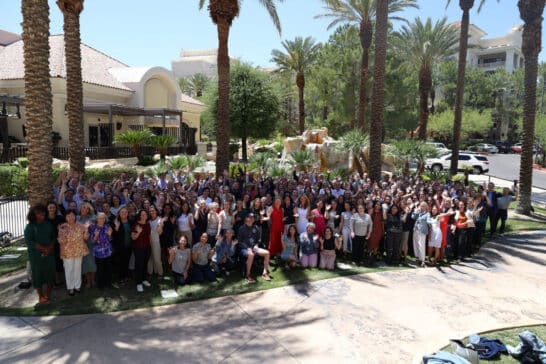“Humanity is a skill that must be learned and his classmates were able to learn it from him.”
(Elementary school teacher Ms. S.)
You don’t really need more of an argument for inclusion.
It’s a topic that is particularly close to the hearts of teachers Ms. S. and Ms. J. from the Torwiesen School in Stuttgart.
Ms. J. is a special needs teacher and has been teaching at the Torwiesen School since 2007 as a designated teacher for the pupils attending the SBBZ (special educational teaching and advisory center) for mental/motor development.
Ms. S. was an elementary school teacher and is now in well-deserved retirement. Her own experiences as a mother of 3 children, the youngest of whom was born with Down’s syndrome, combined with her general enthusiasm for the job, allowed her to contribute a lot of practical knowledge in accompanying disabled children, and she considers inclusion to be a subject close to her heart.
For four years, the two teachers accompanied Jonas Lankenau, a boy with PCH2, through his primary school years at the inclusive Torwiesen School as a pair of class teachers.
In this interview, they look back on this intensive, challenging, but above all educational and enjoyable time.
“Two central aspects for the implementation of inclusion are people’s mindsets (diversity means enrichment) and access to resources.”
(Special needs teacher Ms. J.)
How are lessons organized at your school?
Ms. J: At Torwiesen School, a class consists of two learning groups: one made up of pupils from the SBBZ (physical and mental special needs), and one made up of pupils who follow the elementary school curriculum. The entire class is taught by a multi-professional team.
The concept of joint living and learning at Torwiesen School includes both joint lessons in the classroom and separated periods in the respective learning group. The class teaching team decides which subjects are taught together and at what times.
Factors for this include the curriculum and personal aspects (individual needs of pupils with disabilities) as well as structural aspects (timetable, available rooms and resources).
We are now in the process of developing an internal Torwiesen curriculum, which will enable us to identify suitable topics for joint teaching. The implementation of these topics will be mandatory and in line with the requirements of the respective school curriculum.
For me, this approach is absolutely central to the success of an inclusive school concept that also works in the long term. The result is a structured weekly timetable for each class with joint and separate teaching times. Break times, events and celebrations, excursions and school trips usually take place together at elementary level.
Did you know beforehand that one of your pupils will have PCH2, what the condition is and how severely he is affected?
Ms. J: Yes, I was able to learn about it in advance. A introductory meeting with the parents and the accompanying care team was central to this. If I remember correctly, my colleague (a physiotherapist) and myself visited Jonas at home to meet him in his personal living environment.
What were your first thoughts when you met the pupil?
Ms. S: When my daughter was still young, I once visited an inclusive school in Frankfurt. There was a bed right in the middle of the classroom for a severely disabled child who was able to take part in lessons at any time just as a matter of course. At the center of it all, so to speak. When I met Jonas, I thought to myself: We’ll do exactly the same thing – Jonas right in the middle.
How did you integrate Jonas into the lessons and when was this not possible?
Ms. J: Jonas was an integral and important part of the class community.
His participation in lessons was made possible by the excellent medical and nursing care provided by the Lankenau family’s care team. When Jonas was physically and mentally able to focus his attention on the outside world, he was given individual learning opportunities in line with his level of development. His elementary approach to topics of all kinds enabled the children without disabilities to also approach a topic on a sensorial level, which was always an enrichment for their learning experiences.
We also used many AAC aids so that Jonas could communicate more autonomously or take action on his own (talking buttons, BIGMACK, PowerLink, later eye tracking software and Tobii).
Another very important aspect of Jonas’ participation were social-emotional factors. In this respect, Jonas was a central member of the class community. Many pupils enjoyed physical contact with Jonas, often sought it out and managed their own tension by being near him physically. We were also able to observe this phenomenon through many types of non-verbal communication (facial expressions, eye contact, etc.).
What support did you receive when teaching this student? Would you have preferred more support or was it adequate?
Ms. J: The care team of the Lankenau family gave great support, which was an absolute success factor for teaching Jonas – without this opportunity, we as a school team would not have been able to teach Jonas in this inclusive setting.
Ms. S: Collaborating with the parents was very helpful. And the care team who looked after Jonas and tended to him. The carers were also an important link between Jonas, the pupils and us. Since they knew Jonas well, they sometimes “translated” for him, which made it easier for the other children and us to understand Jonas and connect with him.
What were the biggest challenges of teaching a child with PCH2?
Ms. S: In first grade, it was always a challenge to build a class out of this small scramble of children who all had very different needs. It was great that we were always a team of two. Ms. J. and I complemented each other very well so that we managed to achieve a mixture of good structure and an underlying feeling of “we can do this”.
As far as Jonas was concerned, I was very glad to always have his caregivers at our side. They were able to “translate” to a certain extent as they knew Jonas very well, and gave me the confidence that he would be helped in a (medical) emergency.
What were the challenges for his non-disabled classmates?
Ms. J and Ms. S: Seeing when Jonas wasn’t doing well was certainly a challenge for the other children. Some children also felt unsettled by his movements, trembling or the increased salivation and coughing. In these cases, it helped to talk to the children, take their questions and feelings seriously and explain what was happening.
How did the pupil with PCH2 benefit from the lessons and the interaction with others?
Ms. S: I had the impression that Jonas drew his “life energy” from the other children. He was always in the middle of things, watching, listening and being included. Conversely, he radiated a certain calmness to the other children.
How did the other pupils benefit from learning together with a classmate who has PCH2? And what did you particularly enjoy about teaching Jonas?
Ms. J: Observing how Jonas and his presence expanded the other children’s thinking, opening up new ways of communication as well as perspectives and skills that they would otherwise have missed out on. Seeing how Jonas participated in life within his means, thus achieving a better quality of life and fulfilling his right to education.
Ms. S: Every single one of my pupils has benefited, just as Jonas has benefited from them. I always called Jonas our “gem”. Being human is a skill you have to learn, and where better to learn it authentically than with someone like Jonas.
I have numerous specific stories of how individual children have found more self-esteem, more composure, more compassion through Jonas, but perhaps I can generalize a little: imagine a child with low self-esteem, a child who feels that they are not enough, that they are not “adequate”. This child has learned as part of our class community that everyone is allowed to be themselves, that everyone is adequate.
If Jonas is accepted just the way he is, then I too can be just the way I am. Regardless of my performance in school or my appearance.
At the class council, we once gathered feedback on why the children value Jonas as a classmate. Primary school children gave answers like: Jonas never lies, he’s always honest; you don’t have to pretend in front of Jonas, you can be who you are. That impressed me.
Jonas demanded humanity and compassion from us and we were given maximum humanity in return.
What is your position on inclusion? What does it take to make it a successful concept for everyone involved? What are its limits, what are its opportunities?
Ms. J: Inclusion is a human right. Politicians and society must create a framework that enables participation for all, taking into account individual needs and opportunities. Two central aspects for the implementation of inclusion are people’s mindsets (diversity means enrichment) and access to resources.Ms. S: I feel that the acceptance of inclusion in schools has suffered greatly due to the way it is implemented. In my opinion, it is a delusion that every school is able to create the right conditions for inclusion. That is why I am a great advocate of our concept at Torwiesen School. Inclusion needs special schools that make a commitment, and they need both the staff and space. And inclusion needs people. People who are passionate about building something.
“Jonas demanded humanity and compassion from us and we were given maximum humanity in return.”
(Ms. S, teacher of Jonas)


